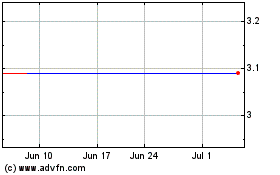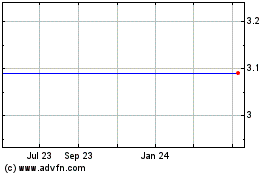Credit Markets: Investors Renew Appetite For CoCos -- WSJ
August 25 2016 - 3:02AM
Dow Jones News
By Christopher Whittall
A complex form of European bank debt has made a comeback in
recent weeks, in the latest sign that investors are willing to take
on higher amounts of risk in their search for positive returns.
Barclays PLC added to a string of recent sales of so-called
contingent convertible -- or CoCo -- bonds Wednesday. These
securities fell sharply out of favor with investors earlier this
year, when there were concerns that German lender Deutsche Bank AG
might fail to make interest payments on some of its bonds. It made
the payments.
The market for new sales of European bank CoCos has picked up in
recent weeks, as Royal Bank of Scotland PLC, Standard Chartered PLC
and UBS Group AG all issued large deals.
The flurry of CoCo issuance has coincided with a fierce rally in
bond markets driven by investors betting on global central banks
keeping extraordinary stimulus in place for longer. Banks love to
sell them because they are a low-pain way of hitting regulatory
capital targets.
Yields on government bonds have plumbed new depths as investors
have pushed up prices. There are more than $13 trillion of bonds
trading at a negative yield, according to J.P. Morgan Asset
Management, up from hardly any at the start of 2014.
That has encouraged investors to scramble for securities
offering higher returns -- from emerging-market debt to risky bank
securities such as CoCos.
Investors piling into CoCos "is a great indicator of the current
strength of the global demand for yield," said Tom Ross, a
portfolio manager at Henderson Global Investors.
European banks have issued more than EUR100 billion ($113
billion) worth of CoCos since 2012, according to CreditSights, to
help build their capital levels as part of a postcrisis regulatory
initiative designed to shield taxpayers from being on the hook for
bank bailouts. CreditSights estimates European banks will sell at
least another EUR100 billion of the securities in the coming
years.
CoCos blur the traditional lines of stocks and bonds.
They don't have a fixed maturity, but they have a "call date"
when the bank is generally expected to redeem them. CoCos also pay
a regular coupon like a bond but, similar to a stock dividend, this
can be skipped at the bank's discretion, or if the bank's capital
cushion is too slender. They can also be written down or converted
into equity if a bank's key capital ratio dips too low.
CoCos sold off earlier this year as fears mounted that Deutsche
Bank would miss a coupon payment because the capital cushion used
to determine whether coupons are paid had thinned.
The broader market has recovered somewhat since then. Investors
in European bank CoCos have now earned a total return of 2.8% this
year, according to Barclays. That compares with a year-to-date
return of minus-11.7% in February, at the height of the concerns
over CoCos, and a positive return of 7.1% last year.
John Raymond, a senior European banks analyst at CreditSights,
said there have been various positive developments for CoCos, among
them the European Commission relaxing restrictions on when banks
can pay out coupons. The Bank of England has also helped by easing
capital requirements for U.K. lenders following the Brexit vote, a
move that should give these banks more leeway to continue paying
CoCo coupons.
According to Dealogic, there have been $27.8 billion of new
sales this year of so-called Additional Tier 1 bonds -- the name of
the main breed of CoCos issued by European banks. That is less than
half the $57.9 billion of these securities sold a year earlier.
But the recent CoCo deals appear to have gone well.
Investors placed more than $15 billion of orders for a $1.5
billion Additional Tier 1 bond sold by Barclays on Wednesday,
according to a person familiar with the matter and a deal notice
released to investors. The bond pays an interest rate of 7.875%,
according to the deal notice.
A spokeswoman for Standard Chartered said there was more than
$20 billion of demand for the lender's $2 billion CoCo sold earlier
this month.
Mr. Ross at Henderson said he bought some of the recent RBS CoCo
bonds because he thinks the bank's creditworthiness is improving
and he liked the high coupon on offer. He is looking to buy the
Barclays bonds for similar reasons.
Even so, he said he is broadly cautious on the asset class,
given its poor performance this year. He also has concerns over the
structure of the securities, which essentially behave like equities
if something goes wrong
"We have to weigh up those risks with the returns available," he
said.
Write to Christopher Whittall at
christopher.whittall@wsj.com
(END) Dow Jones Newswires
August 25, 2016 02:47 ET (06:47 GMT)
Copyright (c) 2016 Dow Jones & Company, Inc.
Royal Bank of Scotland (NYSE:RBS)
Historical Stock Chart
From Mar 2024 to Apr 2024

Royal Bank of Scotland (NYSE:RBS)
Historical Stock Chart
From Apr 2023 to Apr 2024
